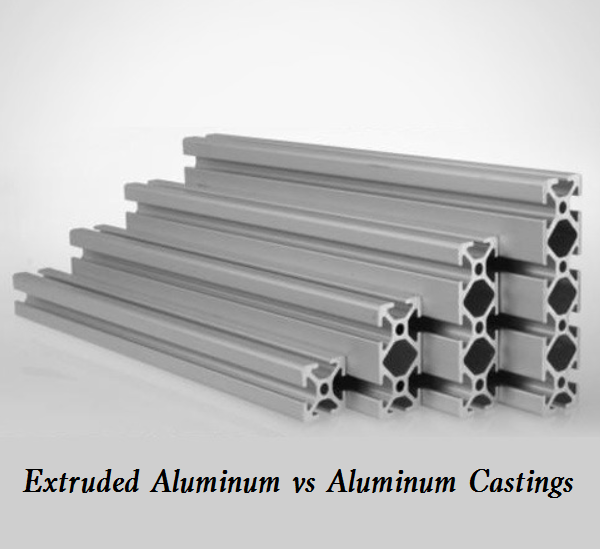How to distinguish the extruded aluminum profiles and die casting aluminum parts? Let’s take a look at the differences between them.

What is Extruded Aluminum?
The production process of extruded aluminum profiles is a post-forming process of high-temperature extrusion of aluminum rods by an extruder. The extruder can be installed with various molds to complete aluminum profiles with different sections.
Advantages of extruded aluminum profiles
– Less processing: because aluminum alloy can be extruded into any complex part. Therefore, as long as the design is reasonable, extruded aluminum alloy profiles can also be easily assembled, thus reducing the need for machining. Some shapes can only be obtained by extrusion, and other processes cannot be obtained.
– Low cost of the aluminum extrusion die: compared with other competitive materials such as rolling, casting, and forging, the cost of the aluminum extrusion die is low.
– High structural efficiency: aluminum extruded profiles can achieve maximum structural efficiency. Name profiles can be used where strength is required, and aluminum profiles can be removed where they are not required.
– Lightweight: extruded aluminum alloy profile is light, strong, and durable. Due to the performance difference between aluminum and other competitive materials, the weight of aluminum structure with the same effect is about half that of other metal structures, while other metals are not easy to process.
– Various surface treatment methods: strong corrosion resistance: powder or electrophoretic coating is adopted, and the designer can achieve any desired color. Of course, it also includes natural silver or color anodized coating.
– Low maintenance: aluminum is a natural and durable metal, and the above surface treatment enhances its durability.
Disadvantages of extruded aluminum profiles
-The organization and performance of the products are uneven. Due to the uneven flow of metal in the extrusion process, the microstructure and properties between the surface layer and the center, the head, and the tail of the extruded products are not uniform.
– The working conditions of extrusion tools and dies are poor, and the tools and dies are worn. During extrusion, the blank is close to the closed state, the tee pressure is high, and the die needs to bear high pressure. At the same time, the tooling die is usually subject to high temperature and high friction during the hot extrusion process, which greatly affects the strength and service life of the die.
– Low production efficiency. Except for the continuous extrusion method developed in recent years, all conventional extrusion methods can not achieve continuous production. Generally speaking, the extrusion speed is far lower than the rolling speed, the geometric waste loss of extrusion production is large, and the yield is low.
Application of extruded aluminum profiles
Extruded aluminum profiles are mainly used to produce broken bridge aluminum doors and windows, electronic radiators, curtain walls, etc.
What are Aluminum Die Castings?
Die cast aluminum has low density, but relatively high strength, close to or higher than high-quality steel, has good plasticity, and can be processed into various profiles, with excellent conductivity, thermal conductivity, and corrosion resistance. It is widely used in industry, second only to steel According to the processing methods, aluminum alloys can be divided into deformed aluminum alloys and cast aluminum alloys: deformed aluminum alloys can withstand pressure processing. It can be processed into aluminum alloys of various shapes and specifications.
Advantages of aluminum die castings
– Because the die-casting aluminum adopts the abrasive die-casting molding process, the die-casting aluminum parts have an accurate size and smooth surface; It is generally used directly without machining. Or the processing amount is small, which not only improves the utilization rate of metal but also reduces equipment and man hours.
– Die casting aluminum castings are cheap; A combination of die-cast aluminum and other metallic or non-metallic materials may be used. Save assembly time and metal.
– Die casting aluminum has high production efficiency. For example, the domestic jiii3 horizontal cold air die casting aluminum machine can die-cast aluminum 600-700 times per 8 hours on average, and the small hot chamber die casting aluminum machine can die-cast aluminum 3000-7000 times per 8 hours on average;
– Die casting aluminum mold has a long service life. The life of a pair of die-casting aluminum dies and die-casting aluminum bell alloys can reach hundreds of thousands of times, even millions of times; It is easy to realize mechanization and automation.
– Die casting aluminum products have good quality and high dimensional accuracy; Die-cast aluminum has a good surface finish, generally equivalent to grade 5-8; The strength and hardness are higher. The strength is generally 25-30% higher than that of sand casting, but the elongation is reduced by about 70%; Stable size and good interchangeability; Can die-cast aluminum thin walls and complex castings.
Disadvantages of aluminum die castings
– Low hardness and poor wear resistance;
– The volume shrinkage during solidification is relatively large, about 6.6%;
– The linear expansion coefficient is relatively high;
– The iron content of the easy adhesive mold shall be strictly controlled within the range of 0.8% – 0.9%;
– Low melting point, limited use at high temperature.
Application of die cast aluminum parts
At present, aluminum alloy die casting technology has been widely used in various fields. At present, aluminum alloy die-casting products are mainly used in auto parts, electronic housings, communications, motors, aviation, ships, home appliances, furniture accessories, digital housings, handicrafts, security product housings, LED lighting (lampshades), and some new energy industries High performance, high precision, and high toughness high-quality aluminum alloy die-casting products are also used in industries with relatively high requirements such as large aircraft and ships. It is mainly used in the parts or housings of some instruments because the aluminum alloy forming process has become a widely used process.

